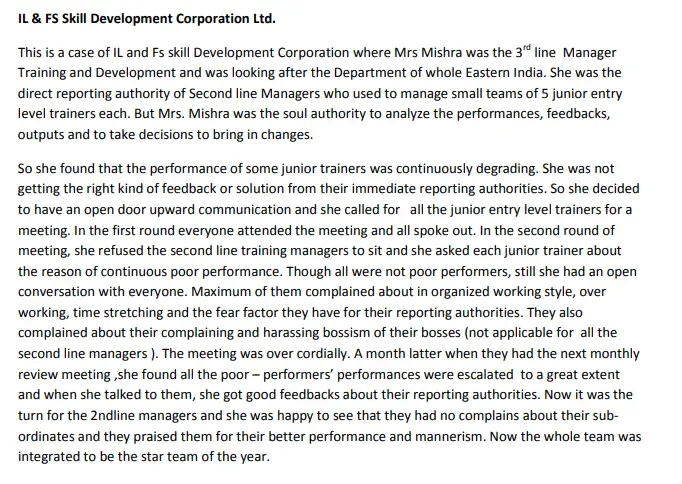Effective communication is essential for the smooth functioning of any organization, whether using upward or downward communication.
In this blog, we will distinguish between upward and downward communication with examples that will help organizations improve their communication strategies and achieve their goals more efficiently.
The Basic Difference Between Upward Vs Downward Communication with comparison table:
Factors for comparison | Upward Communication | Downward Communication |
Meaning | Communication from subordinates to superiors | Communication from superiors to subordinates |
Flow | Flows from bottom to top | Flows from top to bottom |
Objective | Giving feedback and recommendations | Giving orders, assigning tasks and evaluating performance |
Nature | Appealative and informative in nature | Authoritative and directive in nature |
Speed | Time-consuming | Consumes less time |
Frequency | Low | High |
Distortion | More scope for distortion of the message | Less scope for distortion of the message |
Environment | Creates a democratic work environment | Creates an authoritarian work environment |
Form | Suggestions, discussions, and grievances | Orders, circulars, and instructions |
Barriers | Subordinates lacking proper communication skills | Resistance from subordinates |
Experience | Interns and entry-level employees can only communicate upwardly | Experienced workers at higher ranks are eligible for downward communication |
What is the difference between upward and downward communication?
The upward and downward communication differences listed in the table above highlight the following key points of comparison:
1) Meaning: Upward communication is a channel of communication mainly used by subordinates to communicate information and offer feedback to superiors. On the other hand, in downward communication, information flows from superiors down to subordinates in the form of instructions, supervision, and directing performance.
2) Flow: A major difference between upward and downward communication is in the direction of information. In an upward channel of communication, the flow of a message goes from bottom to top, whereas in downward communication, a message moves from top to bottom.
3) Objective: The primary purpose of both upward and downward communication is clear. Members in superior positions utilize downward communication to convey orders and assign tasks, while upward communication is used by subordinates to report to superiors and offer feedback.
4) Nature: Upward communication is submissive and informative in nature as subordinates are under the authority of their superiors and must report information in a formal tone. Contrarily, downward communication is authoritative and directive as superiors are responsible for assigning tasks and giving orders to subordinates.
5) Speed: The speed with which a message is transmitted varies between upward and downward communication. When information flows downward, the speed is usually faster as a manager can contact a subordinate either directly or through an assistant. Whereas, upward communication is more time-consuming as information has to pass through different levels before reaching the desired target,
6) Frequency: The frequency of messages transmitted upward is fairly lower than downward communication as subordinates only communicate with superiors when necessary. On the other hand, superiors have to frequently direct subordinates and monitor performance.
7) Distortion: In upward communication, there is a larger scope for distortion of information due to the message passing through various levels of management, whereas, in downward communication, chances of distortion are lesser as messages are usually transmitted in a formal manner in the form of reports, circulars, etc.
8) Environment: Upward and downward communication have an effect on the work environment. Downward communication creates an authoritative environment where superiors give orders to subordinates, whereas upward communication promotes a democratic atmosphere where subordinates can freely express their grievances, and offer suggestions and feedback on policies.
9) Form: Downward communication usually utilizes channels of the communication process such as reports, circulars, notices, etc. Upward communication occurs mainly orally in the form of subordinates offering feedback, recommendations, complaints, sharing feelings, etc.
10) Barriers: A barrier faced by upward communication is a lack of effective communication skills in subordinates. This can hamper the decision-making ability of managers and lead to potential loss to the company. Whereas, in downward communication, subordinates cannot resist orders from their superiors due to the authoritative nature of communication.
11) Experience: Entry-level employees and interns who are at the lowest levels can only communicate using upward communication as they have no subordinates below them, whereas tenured workers at higher ranks move up in the chain of command and can communicate downwardly with their subordinates.
What are upward and downward communication?
Upward Communication: In an upward channel of communication, a message travels in a bottom-to-top manner from subordinates to superiors. This communication is done frequently as managers require constant feedback from employees to make decisions and ensure business operations are running smoothly.
Upward communication creates feelings of harmony and inclusion in subordinates as they can offer their grievances, thoughts, and ideas to superiors.
Downward Communication: Downward communication refers to a system of communication where information flows in a top-to-bottom manner from superiors to their subordinates.
It follows a pre-defined hierarchy as the information travels down from top executives to department heads to assistant managers and so on. It mainly focuses on giving orders, explaining policies, evaluating employee performances, etc.
Upward and downward communication examples
Example of Downward communication
After AT & T acquired BellSouth and Cingular Wireless, Ed Whitacre, then CEO of AT & T used downward communication to inform the former BellSouth and Cingular employees about the company acquisition strategy. Whiteacre held meetings to assure employees that he understood the changes resulting from the acquisition caused turmoil and confusion in the short term and asked them to continually provide excellent customer service during the transnational period. The face-to-face meeting gave employees the opportunity to ask questions.
Source” Erik S. Lesser/ The New York Times
Example of Upward communication

The above image is a case example of upward communication used to improve the productivity of junior entry-level trainers. Mrs. Mishra third-line manager of training and development used the open-door method to interact with the junior trainer. Communicating with the Junior trainer helped Mr. Mishra to escalate the poor performance.
Upward Communication Advantages & Disadvantages
In this section, we will look at the various benefits and limitations of upward communication.
Advantages of Upward Communication:
1) Encourages employee participation: Upward communication helps in making employees feel like part of the organizational decision-making process by giving them the opportunity to express their thoughts and ideas.
2) Feedback from subordinates: Feedback in communication is a major advantage. Upward communication enables managers to get valuable feedback and key insights from subordinates to make effective decisions and modify policies as needed.
3) Creates a congenial work environment: This channel of communication creates a work atmosphere that promotes a sense of loyalty, trust, and a positive attitude from the subordinates toward superiors.
Disadvantages of Upward Communication:
1) Poor communication skills: Superiors may face difficulties in making quality decisions if the subordinates reporting to them cannot convey information to them in an effective and time-efficient manner.
2) Fear to report: In cases where the information to be reported is unpleasant, it can create feelings of fear in employees towards receiving negative reactions from managers.
3) Slow transmission: Due to following an organizational hierarchy, a message may have to go through multiple people in the chain of command before it reaches the ultimate authority.
Downward Communication Advantages & Disadvantages
In this section, we will look into the importance and limitations of downward communication.
Advantages of Downward Communication:
1) Maintenance of hierarchy: Downward communication ensures the chain of command in the organization is strictly followed by clearly defining members in positions of authority.
2) Clear directions: Managers use this channel of communication to exercise their managerial authority such as assigning specific tasks, and instructions and providing direction to subordinates.
3) Creates discipline: Downward communication demands subordinates to be obedient and follow instructions given by subordinates, which creates order and discipline in the workplace.
Disadvantages of Downward Communication:
1) Lack of feedback: Superiors communicate with subordinates in a directive manner, therefore, there is an absence of receiving feedback from subordinates in a downward communication model.
2) Distortion of the message: A message transmitted through this channel of communication may lose accuracy as it is passed down from top levels of management to lower levels.
3) Resistance from employees: Due to downward communication being authoritative in nature, it can cause subordinates to disobey and resist directions from superiors.
What does the upward and downward communication flow of messages constitute?
Upward and downward communication constitute vertical communication. In this form of communication, information travels either upward – from subordinates to superiors or downward – from superiors to subordinates.
In both channels of communication, the members in positions of authority are clearly defined. In vertical communication, the message passes through the organizational hierarchy in a structured and orderly manner.
Differences between Upward, Downward, and Horizontal Communication
A few key differences between the upward, downward, and horizontal flow of communication are highlighted in the table below:
Basis for comparison | Upward Communication | Downward Communication | Horizontal Communication |
Direction | Flows bottom to top | Flows top to bottom | Flows laterally |
Objectives | Used by subordinates for reporting and giving feedback to superiors | Used by superiors to pass orders, assign roles and evaluate the performance | Used by employees at the same rank to communicate information |
Difference between Vertical and Downward Communication
The major difference to be noted between vertical and downward communication is the flow of information. While vertical communication refers to information being communicated in both up and down directions (subordinate to superior and vice versa), in downward communication, a message is transmitted only in a top-to-bottom direction.
Frequently Asked Questions
Q1) What is an upward communication short answer?
Ans: Upward communication refers to a bottom-to-top system of communication where information flows from subordinates to superiors for the purpose of reporting information and offering feedback.
Q2) What are upward and downward feedback?
Ans: Upward feedback refers to a process by which employees are able to offer feedback on their supervisor’s behavior and performance to the supervisor’s superior, whereas downward feedback is used by managers to evaluate, direct and give the advice to improve an employee’s performance.
Q3) Why is upward communication best?
Ans: Upward communication presents a great opportunity to create a harmonious and congenial work environment by giving employees the opportunity to freely express their feelings and grievances with their co-workers and superiors.
Q4) What is the purpose of downward communication?
Ans: The managers in an organization use downward communication for the purpose of issuing orders, assigning tasks, evaluating job performances, and informing employees of policies and important information.



